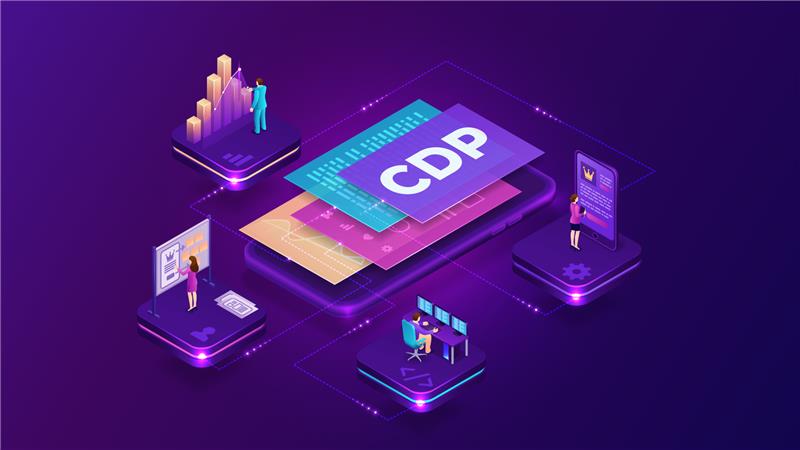Best Practices for a Successful Customer Data Platform (CDP)

Understanding the Role of a Customer Data Platform (CDP)
A Customer Data Platform (CDP) project is not simply a data aggregation and dashboarding program. It is also not a different kind of DMP where the only difference is that data is aggregated and anonymized instead of being segmented by customer.
In this blog, we will bring out some key characteristics of a CDP and will outline 3 best practices of CDP that will help you define and successfully implement a robust CDP for your enterprise.
In today’s digital age, businesses are collecting an enormous amount of customer data from various sources, including website analytics, social media, customer interactions, and more. However, the challenge is to make sense of all this data and derive meaningful insights that can be used to improve customer experiences and drive business growth.
This is where a Customer Data Platform (CDP) comes in – it’s a tool that can help businesses unify and organize their customer data and provide actionable insights.
Do You Need a CDP?
The first step in deploying a CDP is to decide if you need one. Some of the primary criteria for this are:
- Your AI models and business intelligence are siloed and don’t talk to each other. E.g. You cannot easily perform what-if analytics based on AI outputs.
- Your AI insights are not easily operationalized or used by your business applications
- Your AI insights are not integrated in real time with your business applications
These needs are more than just requiring a consolidated database for customer segmentation and installing reporting and dashboarding tools.
So, in short, if you have data silos, disconnected customer experiences, and a lack of actionable insights integrated in real time, then a CDP is right for you.
Otherwise, you should proceed with deploying a nice reporting and dashboarding tool.
Key Best Practices of CDP:
Identify the Key AI and Business Intelligence Use Cases
A CDP program should be action led.
In contrast, a data lake program is data led where the priority is to feed it everything we can get. A CDP on the other hand must start with the actionable outcomes we want to drive.
We should start by defining the business objectives and the specific insights we want to derive from the customer data. This will help us identify the key use cases that the intended CDP should support.
For example, in a retail or digital business, we may want to understand our customers’ purchasing behavior, preferences, and motivations. This could involve analyzing data from various sources, such as purchase history, browsing behavior, demographic data, and social media interactions. In addition, we may want to uplift promotion effectiveness, improve cross sell rates, reduce cart abandonments, etc.
By identifying the key use cases, we can ensure that the CDP provides the necessary functionality and features to support our business objectives.
Defining the use cases first also ensures that we have a clear blueprint for our data needs. It makes it easier to then run a discovery program across the enterprise to see how best those data needs can be met.
Engaging Stakeholders: Collaboration and Buy-In
It is natural that defining the use cases needs active engagement of various stakeholders to secure buy-in and collaboration.
That’s because deploying a CDP is a business initiative that requires collaboration and buy-in from stakeholders across business units from marketing, sales, customer service, technology, and others. It’s essential to engage stakeholders early on in the process to ensure that the benefits case for the CDP is sound.
Even though the initial scope may be small, we are likely not going to build multiple CDPs over time. So, by involving multiple stakeholders and following a design thinking approach, we can ensure that the planned CDP is scalable enough to meet future needs as can be reasonably defined. This will also help build a sense of ownership and accountability for the success of the CDP deployment.
Identify Data Sources and Existing Tech Landscape
Existing tech landscape and data sources are crucial to consider. For example, we may need to analyze the maturity of the data lake, if any, to determine if it can be used as the base for the data in the CDP, or whether multiple data integrations will be needed.
Additionally, it’s important to consider how to migrate from or leverage existing visualization tools. This may involve integrating the CDP with existing BI tools or migrating to a new platform that complements the CDP’s capabilities.
Since AI is an important driver of the CDP, the technology landscape for AI and machine learning operations should also be evaluated. Traditionally, enterprises have used isolated tools to create and train their AI models, and then run into challenges with making the insights available in real time. That’s because hosting of the AI models and making them available in real time needs a separate platform. In addition, integration of the insights with the reporting tools for active what-if analysis must be considered.
Thus, in our opinion, if possible, the target CDP technology should be evaluated for simplifying this AI operational model as well. Doing this well will have a big impact on how well AI is integrated with various business applications.
It’s important at this time to recognize the critical role that IT plays in deploying a CDP. Multiple IT teams will be responsible for ensuring the security, scalability, and reliability of the CDP infrastructure. They will also be instrumental in defining the data fabric necessary for the CDP. Therefore, it’s important to collaborate closely to ensure that the CDP meets their enterprise architecture strategy and is compatible with the existing IT infrastructure as much as possible.
Integrated AI Capabilities: Enhancing Insights and Real-Time Integration
A common mistake is to think of a CDP just as a highly segmented data store for customer data. That results in decisions that prevent the AI, BI, and last mile integration of insights to come together well.
Therefore, using a traditional enterprise BI tool on top of a segmented datastore does not make for a CDP. We must also integrate the desired AI models inside the same conceptual block.
The insights from these AI models should be integrated with the dashboards so that sophisticated what-if analysis can be performed based on predictive insights, not just simple trend analysis. For example, we may want to know the effect on revenue by region if the price is changed for a specific product. Having advanced analytics handle that is a much better alternative to simple trends analysis. A CDP should be capable of handling that.
Finally, the integration of these AI insights must be possible in real-time with the business applications. In fast paced eCommerce and digital media scenarios, real time personalization and actions can make a big difference in outcomes. If the customer facing systems can retrieve AI decisions in real time using APIs, this becomes much easier to manage than in a scenario where insights must be ingested in batch mode. Introducing latencies in business processes must be avoided as much as possible.
Conclusion: Unlocking the Value of Customer Data with CDP
In conclusion, deploying a CDP that integrates AI, BI, and promotes last mile integration of insights is a crucial step in unlocking the value of your customer data and driving business growth. Starting with the applications of insights, clearly understanding the tech integrations, and deploying a CDP that integrates AI will significantly increase the chances of success.
Look up our customer data platform accelerator that brings this vision to life. Also check out our AI based data integration utility that can make enterprise data integrations a breeze by automating the discovery of data and reducing your ETL efforts dramatically.
Click here to know more about this solution.
